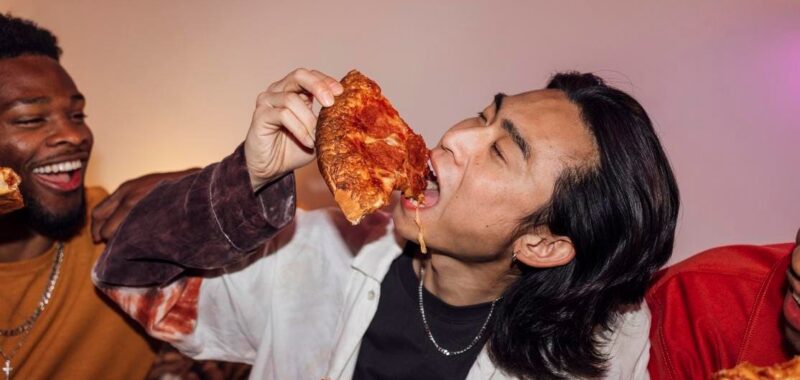What are the munchies—and why does weed increase appetite in such a specific, intense way? This … More
Yes, it’s more than a meme. The “munchies” effect—those sudden, often intense cravings for salty, sweet, or high-fat snacks after cannabis use—isn’t just anecdotal. It’s biological.
According to a 2009 study in Nature Neuroscience, cannabis compounds activate the brain’s endocannabinoid system, which heightens our senses of smell and taste. That sensory boost makes food more appealing and can override the body’s natural signals of fullness. THC also promotes the release of the hunger hormone ghrelin, which further stimulates appetite and encourages food-seeking behavior. In short, weed doesn’t just make you hungry—it makes food feel more vivid, more rewarding, and harder to resist.
But it’s not just about flavor. A 2019 study in the Journal of Psychopharmacology found that cannabis also increases dopamine activity in the striatum, the part of the brain that controls reward-seeking behavior. So the munchies aren’t just a reaction—they’re a reward loop. A full-body yes to whatever feels good, fast, and easy. That said, the effect isn’t one-size-fits-all. Chronic cannabis use can alter how the reward system responds over time, and not all users experience the same intensity of dopamine-driven food desire.
That might explain why cannabis-friendly food holidays like 4/20 have become unofficial showcases for fast-food indulgence. From extra-cheesy nachos to triple-patty burgers, the food isn’t just functional—it’s engineered to satisfy every level. The appeal is emotional as much as it is physical. A craving, yes—but also a comfort.
Cravings, Meet Convenience
Fast food and weed go hand in hand—but it’s not random. When you get the munchies, you’re looking … More
But the munchies don’t happen in a vacuum. What we reach for when that craving hits is shaped by something else entirely: culture. And in 2025, that culture is increasingly fast, familiar, and available through an app.
A recent Tastewise survey found that 75% of Americans eat fast food at least once a week. Among Gen Z and Millennials, nearly half say they’re eating more fast food than they were just a year ago. Their top reasons? Cravings, comfort, and convenience.
That trifecta is also the blueprint for a munchies meal. Salty. Satisfying. No prep required. So when 4/20 rolls around, it’s not just a stoner holiday anymore. It’s a high-demand food moment—one where brands can lean into what consumers are already doing when they’re tired, overstimulated, or emotionally frayed: reaching for something hot, fast, and reliable.
From Stigma to Study
The munchies aren’t just slang. From global health surveys to neuroscience labs, researchers are … More
What used to be whispered about is now tracked in government databases. In the latest WHO Global School-based Student Health Survey, cannabis use is listed right alongside fast food, soda, and physical activity as a behavioral health metric.
That might not seem groundbreaking on its face. But it points to a broader shift in how cannabis is framed—not as moral failure, but as measurable behavior. Not as deviance but as data.
That shift matters. When public health frameworks start treating cannabis use the same way they treat food frequency or screen time, brands are quick to follow. Not with warnings—but with promotions. With late-night bundles. With stoner-safe snacks that feel more like self-care than vice.
A Bigger Audience for the Munchies
Who gets the munchies? Not just teens or stereotypes. With cannabis use up across Millennials and … More
That normalization shows up in the numbers, too. According to Gallup, 16% of U.S. adults said they smoke marijuana in 2022—up from just 7% in 2013. That’s a doubling in less than a decade, thanks to legalization, cultural softening, and a generational shift in what cannabis means.
It’s not just a niche anymore. It’s mainstream. And fast food brands are watching.
For Millennials and Gen Z—many of whom came of age alongside dispensary menus and infused gummies—4/20 doesn’t feel transgressive. It feels like a craving calendar. And the brands lining up to feed it? They know it’s not just about the weed. It’s about what comes after. The bite. The hit. The relief.
A New Kind of Craving
Cannabis cravings don’t always lead to junk food—and they aren’t always unhealthy. As brands race to … More
Cannabis users aren’t fringe anymore—and brands know it.
In recent years, everyone from Taco Bell to Jack in the Box to Fatburger has rolled out food and drink promotions that nod to the 4/20 crowd without saying the quiet part out loud. The strategy is familiar: bigger, bolder, cheesier. Add more sauces. Name it something slightly chaotic. Drop it after 10 p.m.
And yes—it’s working. According to a recent GlobalData survey, early findings show a potential rise in the consumption of savory snacks, chocolate, and confectionery, especially in North America. Unlike the energy drink space, where Gen Z dominates, these snack spikes are driven largely by older Millennials and Gen X.
In other words, the munchies market isn’t just younger—it’s broader. And it’s reshaping what indulgence looks like across demographics.
The relationship between cannabis, appetite, and health isn’t as linear as it looks. While cannabis clearly heightens cravings, studies suggest it isn’t necessarily linked to obesity—and may even correlate with lower diabetes risk. That tension between indulgence and impact complicates the old narratives. The munchies aren’t just about eating more. They might be about eating differently—or seeking out satisfaction on entirely different terms.
MORE FROM FORBES

